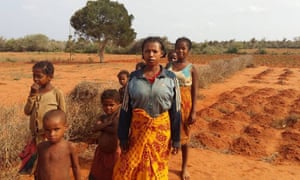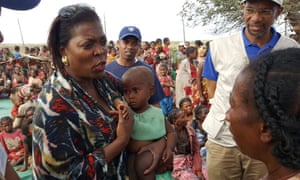MADAGASCAR DROUGHT: 330,000 PEOPLE ‘ONE STEP FROM FAMINE’, U.N. WARNS
THE GUARDIAN
Food and Agriculture Organisation says 330,000 people are on verge of ‘a food security catastrophe’ following sustained drought that has decimated crops

The severe drought afflicting southern Madagascar has left 330,000 people on the brink of famine, a senior UN official has warned.
Three successive years of failed rains have left the island nation wrestling with crop failure and a chronic lack of food and clean drinking water, with agencies warning last month that nearly 850,000 people are experiencing “alarming” hunger levels.
“Three hundred and thirty thousand are on the verge of a food security catastrophe, next step being famine,” said Dominique Burgeon, director of emergencies and rehabilitation at the UN’s Food and Agriculture Organisation (FAO).
“People go from one lean season to the next, resorting to negative coping strategies. People are eating anything to fill their stomachs, selling most of their belongings, cattle and land. It shows the severity of the situation and the need for us to act.”
Farmers talk of the earth changing; of failed rains and crops, and barren land. Meanwhile, agencies are fighting a desperate rearguard action. Unicef, the UN children’s agency, reports growing demand for the high-calorie, peanut-based paste used to combat severe acute malnutrition.
“People are living under extreme conditions. We are dealing with a development crisis that has lasted for decades now, worsened by El Niño. For many, it is day-to-day survival,” said Elke Wisch, country representative for Unicef Madagascar.
Wisch emphasised the need to build resilience in the disaster-prone country, where food production has all but ground to a halt as the El Niño weather phenomenon exacerbates the effects of the drought. “We know that natural disasters will occur,” she said. “The important thing is how the local population can respond to these shocks.”
Yet mounting any kind of response is complicated by huge funding shortfalls. The World Food Programme’s (WFP) operations across seven countries in southern Africa are only 50% funded between now and April, with the total deficit at roughly $300m. The organisation’s $82m drought relief operation in Madagascar, which runs until March 2017, faces a $50m shortfall.

The FAO is also struggling, with a $17.5m shortfall limiting the distribution of emergency packages to 75,000 of the the 175,000 farming households in need.
Appealing for further donations, both organisations have stressed the importance of the forthcoming planting season. “If we miss planting season, the need for food assistance could go into March 2018,” warned Burgeon.
Either way, the situation is likely to get worse before it gets better. Poor infrastructure makes it difficult to get assistance to remote areas of the south, with journeys of more than 200km likely to take days by road.
Moreover, nutritional challenges are endemic, with more than 50% of children suffering from stunted growth, a condition caused by malnutrition over the first 1,000 days of life. The issue costs the world’s sixth poorest country an estimated $740m a year, roughly 7% of its GDP.
“We have not even reached the peak yet, we are four to five months away from the next harvest,” said David Orr, the WFP’s regional spokesperson.
Madagascar’s president, Hery Rajaonarimampianina, will be anxious to ensure that infrastructure issues in Antananarivo, the country’s gridlocked capital, do not impinge on the hosting of a summit for French language states this weekend. With hotel swimming pools being used for drying sheets and laundry, and the city’s river running lower than normal due to its use for bathing, washing and stone production, Antananarivo has not been untouched by the effects of the drought.
After the summit, Rajaonarimampianina will travel to the Paris headquarters of the UN Educational, Scientific and Cultural Organisation for a donor conference.
In the absence of more immediate support, however, farmers in the region reliant on rain-fed agriculture face a precarious existence. “Worst case is another crop failure,” said Wisch. “Then you are looking at – and we’re starting to see this now – people eating seeds instead of planting them. That is a desperate situation.”








Follow Us!